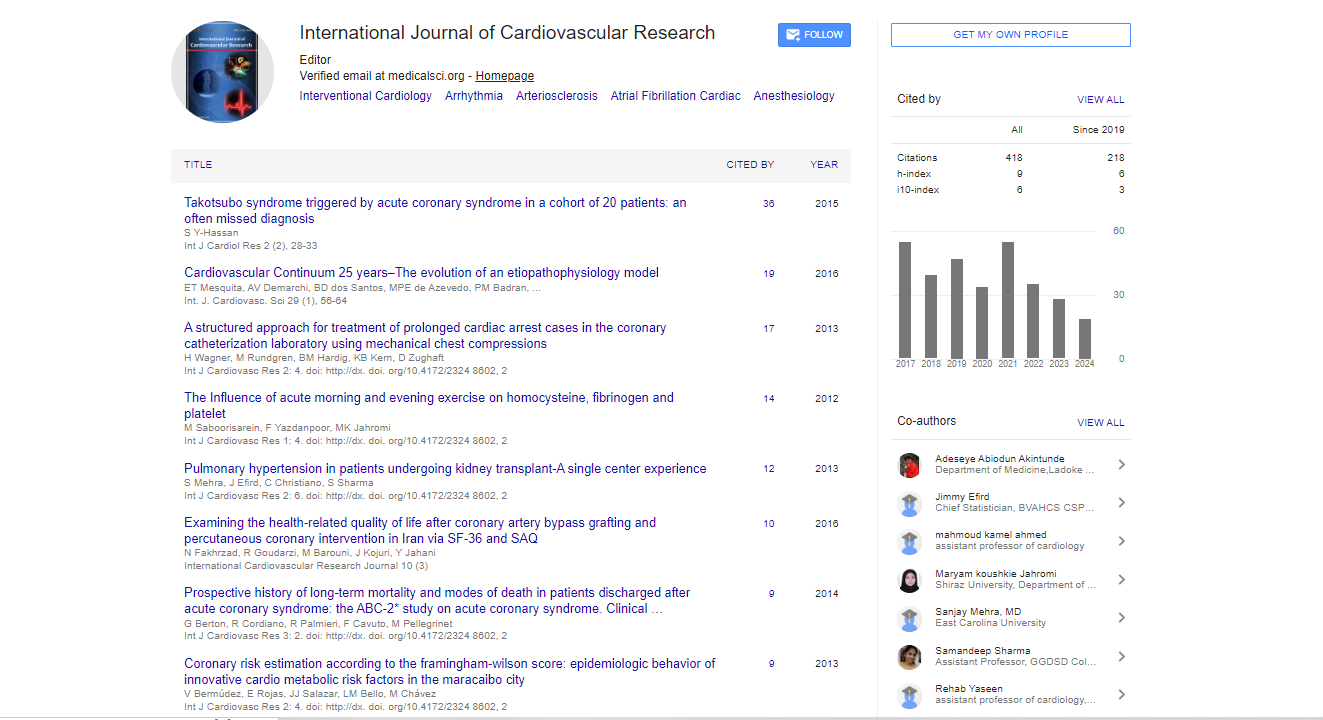Short Communication, Int J Cardiol Res Vol: 13 Issue: 5
Heart Disease and Obesity: Analysis of their Interrelationship and Implications for Health
Kevin Brown*
1Department of Cardiology, UCSF School of Medicine, California, United States of America
*Corresponding Author: Kevin Brown,
Department of Cardiology, UCSF School of
Medicine, California, United States of America
E-mail: kevin.brown@sciencehub.org
Received date: 23 September, 2024 Manuscript No. ICRJ-24-153185;
Editor assigned date: 25 September, 2024, PreQC No. ICRJ-24-153185 (PQ);
Reviewed date: 09 October, 2024, QC No. ICRJ-24-153185;
Revised date: 16 October, 2024, Manuscript No. ICRJ-24-153185 (R);
Published date: 23 October, 2024, DOI: 10.4172/2324-8602.1000588
Citation: Brown K (2024) Heart Disease and Obesity: Analysis of Their Interrelationship and Implications for Health. Int J Cardiol Res 13:5.
Description
Obesity, defined as an excessive accumulation of body fat, has become one of the leading public health challenges of the 21st century. The interrelationship between heart disease and obesity is complex, involving a combination of metabolic, inflammatory and mechanical factors that synergistically elevate the risk for cardiovascular pathology. Obesity is primarily characterized by an increase in Body Mass Index (BMI), with a BMI of 30 or greater typically denoting obesity [1]. It results from an imbalance between calorie intake and energy expenditure, often exacerbated by factors such as poor diet, physical inactivity, genetics and environmental influences. However, obesity is not simply an issue of body weight but a complex disorder involving the dysregulation of various biological systems, including metabolic and endocrine pathways. Adipose tissue, once regarded as a passive fat reservoir, is now understood to play an active role in the pathophysiology of obesity related diseases. This tissue secretes numerous bioactive molecules, including adipokines, cytokines and hormones, which affect metabolic processes and inflammation [2-5].
One of the most significant contributors to heart disease in obese individuals is insulin resistance. As adiposity increases, the body’s sensitivity to insulin diminishes, leading to elevated blood sugar levels and an overproduction of insulin by the pancreas. Over time, this insulin resistance can lead to Type 2 diabetes, a condition strongly linked to cardiovascular disease. In addition, obesity is associated with dyslipidemia, characterized by elevated levels of triglycerides, Low- Density Lipoprotein (LDL) cholesterol and decreased levels of High- Density Lipoprotein (HDL) cholesterol [6]. These lipid abnormalities contribute to the formation of arterial plaques, a characteristic of atherosclerosis, which is the underlying cause of many forms of heart disease, including CAD. Obesity-induced chronic low-grade inflammation is a key driver of the cardiovascular consequences associated with excess body fat. Adipose tissue, particularly visceral fat, secretes pro-inflammatory cytokines such as TNF-α, IL-6 and leptin, which promote systemic inflammation. This inflammatory state contributes to endothelial dysfunction, a condition where the inner lining of blood vessels becomes damaged, making them more prone to atherosclerotic plaque formation [7]. Additionally, oxidative stress, a condition characterized by an imbalance between the production of free radicals and the body’s ability to neutralize them, is amplified in obesity. Free radicals damage blood vessels, leading to the progression of atherosclerosis and other cardiovascular events.
Obesity is strongly associated with hypertension, or high blood pressure, which significantly increases the risk of heart disease. Excess adiposity leads to changes in vascular tone and resistance, often due to the increased release of angiotensinogen by adipocytes. This hormone is a precursor to angiotensin II, a potent vasoconstrictor that increases blood pressure [8]. Additionally, obesity-related hormonal changes, including alterations in the Renin-Angiotensin- Aldosterone System (RAAS), further exacerbate the hypertensive state. Hypertension accelerates the development of atherosclerosis and increases the workload on the heart, contributing to the development of heart failure [9,10]. The mechanical strain imposed by excess body weight also plays a critical role in the development of heart disease. As obesity increases, the heart has to work harder to pump blood throughout the body. This chronic overload can lead to the enlargement of the heart, a condition known as Left Ventricular Hypertrophy (LVH). LVH increases the risk of arrhythmias and heart failure, particularly diastolic heart failure, where the heart’s ability to relax and fill with blood is impaired. Additionally, obesity-induced sleep apnea, a common condition in obese individuals, exacerbates the risk of heart disease by causing intermittent hypoxia, which further stresses the heart and elevates blood pressure.
Conclusion
The relation between obesity and heart disease is complicated, with obesity serving as both a cause and an amplifier of cardiovascular risks. The pathophysiology of this relationship is multifactorial, involving insulin resistance, inflammation, hypertension and mechanical strain on the heart. However, through preventive measures such as lifestyle changes, pharmacotherapy and surgical interventions, the adverse effects of obesity on heart health can be reduced.
References
- Alexander JK. (2001) Obesity and coronary heart disease. Am J Med Sci 321(4):215-324.
- De Schutter A, Lavie CJ, Milani RV. (2014)The impact of obesity on risk factors and prevalence and prognosis of coronary heart disease the obesity paradox. Prog Cardiovasc Dis 56(4):401-408.
- Garrison RJ, Higgins MW, Kannel WB. (1996) Obesity and coronary heart disease. Curr Opin Lipidol 7(4):199-202.
- Keys A, Aravanis C, Blackburn H, Van Buchem FS, BUZINA R, et al. (1972) Coronary heart disease: Overweight and obesity as risk factors. Ann Intern Med 77(1):15-26.
- Donahue R, Bloom E, Abbott R, Reed D, Yano K. (1987) Central obesity and coronary heart disease in men. Lancet 329(8537):821-824.
- Abbasi F, Brown BW, Lamendola C, McLaughlin T, Reaven GM. (2002) Relationship between obesity, insulin resistance and coronary heart disease risk. J Am Coll Cardiol 40(5):937-943.
- Stefan MA, Hopman WM, Smythe JF. (2005) Effect of activity restriction owing to heart disease on obesity. Arch Pediatr Adolesc Med 159(5):477-481.
- Alpert MA, Hashimi MW. (1993) Obesity and the heart. Am J Med Sci 306(2):117-123.
- Eckel RH. (1997) Obesity and heart disease: A statement for healthcare professionals from the Nutrition Committee, American Heart Association. Circulation 96(9):3248-3250.
- Katta N, Loethen T, Lavie CJ, Alpert MA. (2021) Obesity and coronary heart disease: Epidemiology, pathology and coronary artery imaging. Curr Probl Cardiol 46(3):100655.
 Spanish
Spanish  Chinese
Chinese  Russian
Russian  German
German  French
French  Japanese
Japanese  Portuguese
Portuguese  Hindi
Hindi 



